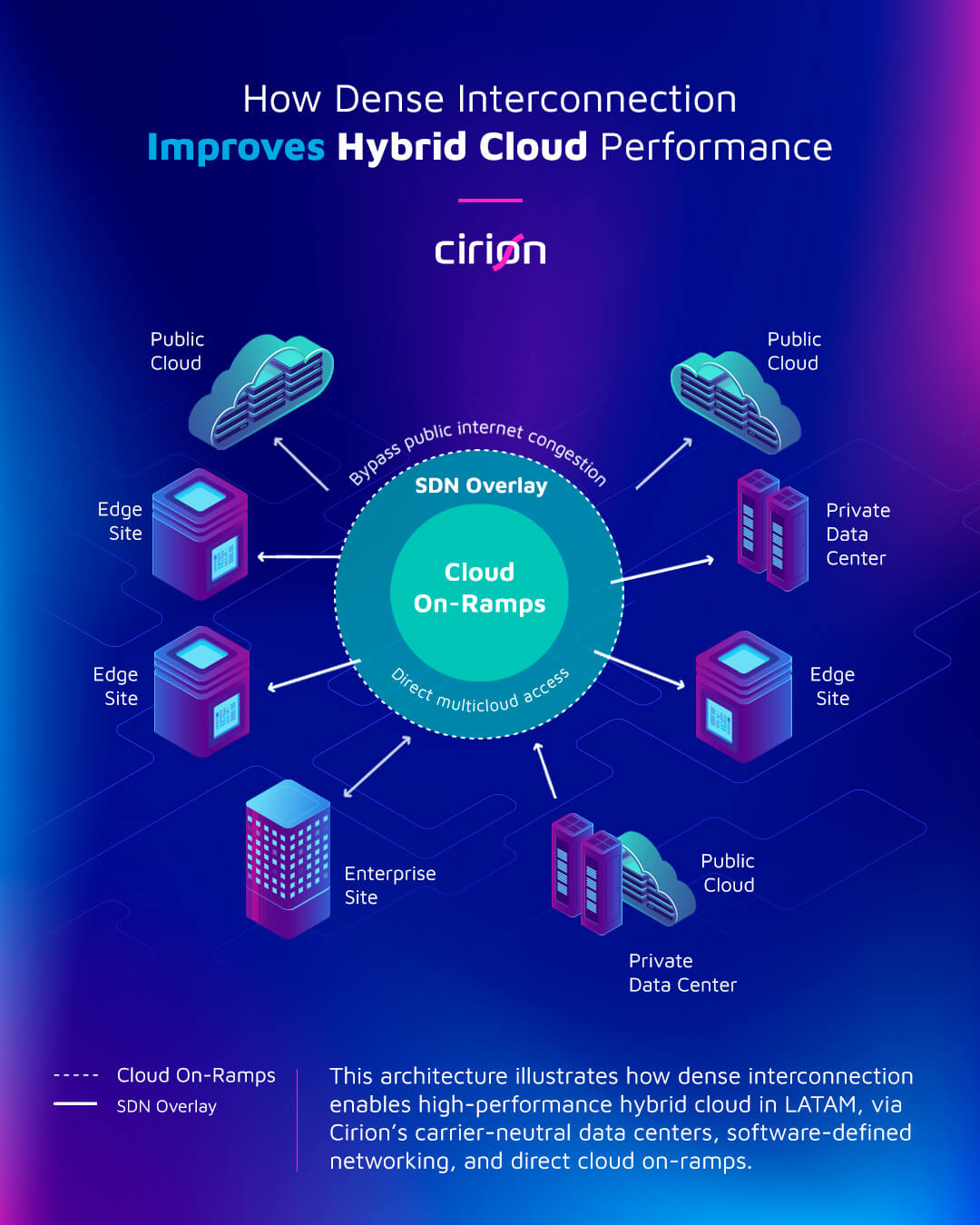No longer a fringe strategy, hybrid cloud is the backbone of modern IT, with the hybrid cloud market worth over USD172 billion in 2025.

By blending the control of private infrastructure with the scalability of public cloud, enterprises can use hybrid cloud to tailor their environments to suit their performance, compliance, and cost needs. But hybrid doesn’t automatically mean high-performing.
Many enterprises struggle with the “hybrid tax”: inconsistent latency, network bottlenecks, and the unpredictable application behavior that comes from connecting fragmented environments. Whether it’s a time-sensitive data sync or a multi-region app rollout, performance glitches in hybrid architectures can hit teams hard. So, what’s the missing link?
Dense interconnection—a strategic, architecture-level approach to network design—is emerging as the fix. And for cloud architects, DevOps teams, and infrastructure planners trying to build scalable, resilient hybrid environments across Latin America, dense interconnection isn’t just a nice-to-have – it’s now a must.
What is dense interconnection?
Built on a foundation of data center interconnects, dense interconnection refers to the highly connected physical and virtual infrastructure that facilitates seamless, low-latency data exchange between a broad ecosystem of networks, clouds, and partners.
Unlike basic internet peering or standard cloud connectivity, which often rely on longer and less direct routes, dense interconnection is:
- Localized within carrier-neutral data centers
- Purpose-built using direct cross-connects, cloud on-ramps, and software-defined networking
- Ecosystem-rich, with access to multiple clouds, carriers, and service providers in the same facility.
But what truly sets a dense interconnection ecosystem apart is the breadth of participants—not just networks and clouds, but also enterprises, SaaS platforms, content providers, and other service partners. This broader mix transforms a data center into a high-performance digital marketplace, enabling fast, local exchanges between all the critical players in today’s IT landscape. It’s also one of Cirion’s key differentiators across Latin America.
Think of dense interconnection like a digital traffic hub. Instead of routing data through a chaotic freeway (like the public internet), dense interconnection lets you send your workloads down direct express lanes—private, fast, and built for scale.
Dense interconnection is an especially useful approach in a market like LATAM as US-based and global companies look to unlock its booming market while trying to overcome the unique set of challenges it presents.
Components of dense interconnection
- Data Centers and edge locations
These act as the physical nodes of your dense interconnection network; the places where data exchange, application hosting, and connectivity happen. The more strategically placed data centers and edge sites you have access to, the denser and more efficient your interconnection fabric becomes. - Cross-connects
Cross-connects are dedicated physical links between your equipment and other colocated networks or cloud providers. They eliminate the latency and variability of the public internet, offering a secure, low-latency path ideal for high-performance workloads. - Cloud on-ramps
Native integrations with public cloud platforms—including AWS Direct Connect and Google Cloud Interconnect, and Oracle Cloud—allow for fast, reliable, and cost-effective access to cloud services directly from the data center. Other platforms such as Azure ExpressRoute are also supported via extended connectivity. - Carrier neutrality
In carrier-neutral facilities, you’re not locked into a single provider. You have the flexibility to choose from a diverse mix of network carriers, cloud providers, and service partners, enabling redundancy, competition, and agility. - Software-defined interconnection
Software-defined interconnection platforms allow you to create and manage virtual interconnections on demand. Use their connectivity fabric to spin up secure links between data centers, cloud providers, or business partners in minutes – no physical rewiring needed. This gives DevOps teams the control and speed they need to support agile cloud operations.
Together, these elements make dense interconnection not just a network design choice, but a key enabler of hybrid and multi-cloud success.

The role of dense interconnection in a hybrid cloud architecture
In a hybrid setup, workloads often need to move between on-premises infrastructure and public cloud platforms. These transitions need to be fast, secure, and reliable, particularly for real-time apps, large data transfers, or multi-cloud orchestration.
- On-prem to cloud migration: Direct cross-connects between colocated private infrastructure and cloud on-ramps enable seamless, high-speed data transfers with minimal disruption.
- Multi-cloud orchestration: Dense ecosystems allow organizations to interconnect workloads between AWS, Azure, Google Cloud, and other cloud providers without backhauling traffic across continents.
- Disaster recovery and backup: Redundant interconnection paths across regions make it possible to replicate data quickly and securely for failover strategies.
- AI model training: Enterprises can run data preprocessing and model refinement on colocated infrastructure, then train AI/ML models using GPU-based services in the public cloud (like Google Vertex AI, AWS SageMaker, or Azure ML) over low-latency, private links—accelerating development and controlling costs.
Performance benefits of dense interconnection
Dense interconnection doesn’t just improve your network performance – it stabilizes it. And when latency, bandwidth, and reliability become predictable, so does your entire cloud architecture.
Benefits include:
- Lower latency: By bypassing the public internet and using direct routes to cloud providers, you eliminate unnecessary hops that introduce jitter and lag.
- Higher throughput: Physical cross-connects and virtual interconnection services provide scalable bandwidth options, ideal for AI adoption, big data workloads, or burstable traffic patterns.
- Improved availability: Redundancy across multiple providers and paths ensures that your hybrid environment stays online even if one connection fails.
- Cost optimization: Direct connections help avoid cloud egress fees and reduce the need for extra security tools (like VPNs), lowering both usage and compliance costs.
- Faster setup time: Direct cross-connects and pre-integrated cloud on-ramps reduce provisioning time and deployment delays.
- Enhanced security: Traffic avoids the public internet, minimizing exposure and reducing the need for additional security layers like VPNs.

Real-world use cases
Across Latin America, enterprises are already unlocking the benefits of interconnection-ready data centers:
- Carrier and cloud-neutral ecosystems: Enterprises colocated in carrier-neutral facilities gain direct access to a diverse mix of network providers and CSPs, with rich peering options.
- Integrated cloud on-ramps: Platforms like AWS Direct Connect, Azure ExpressRoute, and Google Cloud Interconnect are available natively within strategic interconnection hubs, reducing setup time and improving performance.
- Software-defined interconnection: Enterprises can dynamically spin up or reconfigure connections across providers, clouds, and geographies – all without touching physical infrastructure.
- Edge proximity: Hosting workloads closer to end users and regional cloud zones improves UX and application responsiveness in key LATAM markets.
How to set up dense interconnection
Setting up dense interconnection starts with colocating in the right facility – one that offers high availability, rich ecosystem access, and native on-ramps to major cloud platforms. From there, it’s about layering in the right connectivity options to match your hybrid architecture goals.
To build a dense interconnection fabric, follow these steps:
- Choose a carrier-neutral data center in a strategic location near cloud regions or key user bases.
- Establish direct cross-connects to cloud providers, SaaS platforms, and network partners to reduce latency and avoid public internet routes.
- Leverage cloud on-ramps (e.g., AWS Direct Connect, Azure ExpressRoute) to streamline cloud access and control costs.
- As software-defined interconnection becomes more widely adopted, forward-looking organizations will gain even greater agility through virtual connectivity platforms—something Cirion is actively exploring for future offerings.
- Design for redundancy and scalability by using multiple carriers and interconnection paths across your critical sites.
A densely interconnected LATAM data center provider like Cirion provides the integrated interconnection-ready infrastructure and expert support to help you deploy quickly. Whether you’re modernizing workloads or expanding into new regions, this approach gives your hybrid cloud the reliable backbone it needs to perform.
Cirion’s interconnection-ready infrastructure
Cirion is uniquely positioned to support hybrid cloud performance through its Digital Infrastructure solutions: an integrated suite of colocation, connectivity, and cloud enablement services.
With a broad footprint of data centers across Latin America, Cirion enables enterprises to:
- colocate critical workloads alongside interconnection hubs and direct cloud access points;
- leverage high-density peering ecosystems that connect them to regional carriers, hyperscalers, and SaaS providers; and
- integrate with regional fiber routes and global backbone networks for high availability and predictable latency.
Conclusion
Hybrid cloud isn’t slowing down – but without robust interconnection, it risks becoming more complex than competitive.
Dense interconnection gives cloud and network teams the control, visibility, and performance needed to optimize their workloads. And whether you’re migrating data, building a disaster recovery plan, or connecting across clouds, Cirion’s infrastructure helps turn your hybrid cloud from a risk to a strategic advantage.
Explore Cirion’s Digital Infrastructure.
About the Author
Guido Cambiasso is Director of Product Development and Tools & Automation at Cirion Technologies, leveraging his extensive expertise in data center, cloud, and security infrastructure across Latin America. With a proven background including leadership roles at Lumen (formerly CenturyLink) where he drove regional tech and process innovation, Guido brings both strategic vision and hands‑on experience to this thought‑leadership post. – LinkedIn











